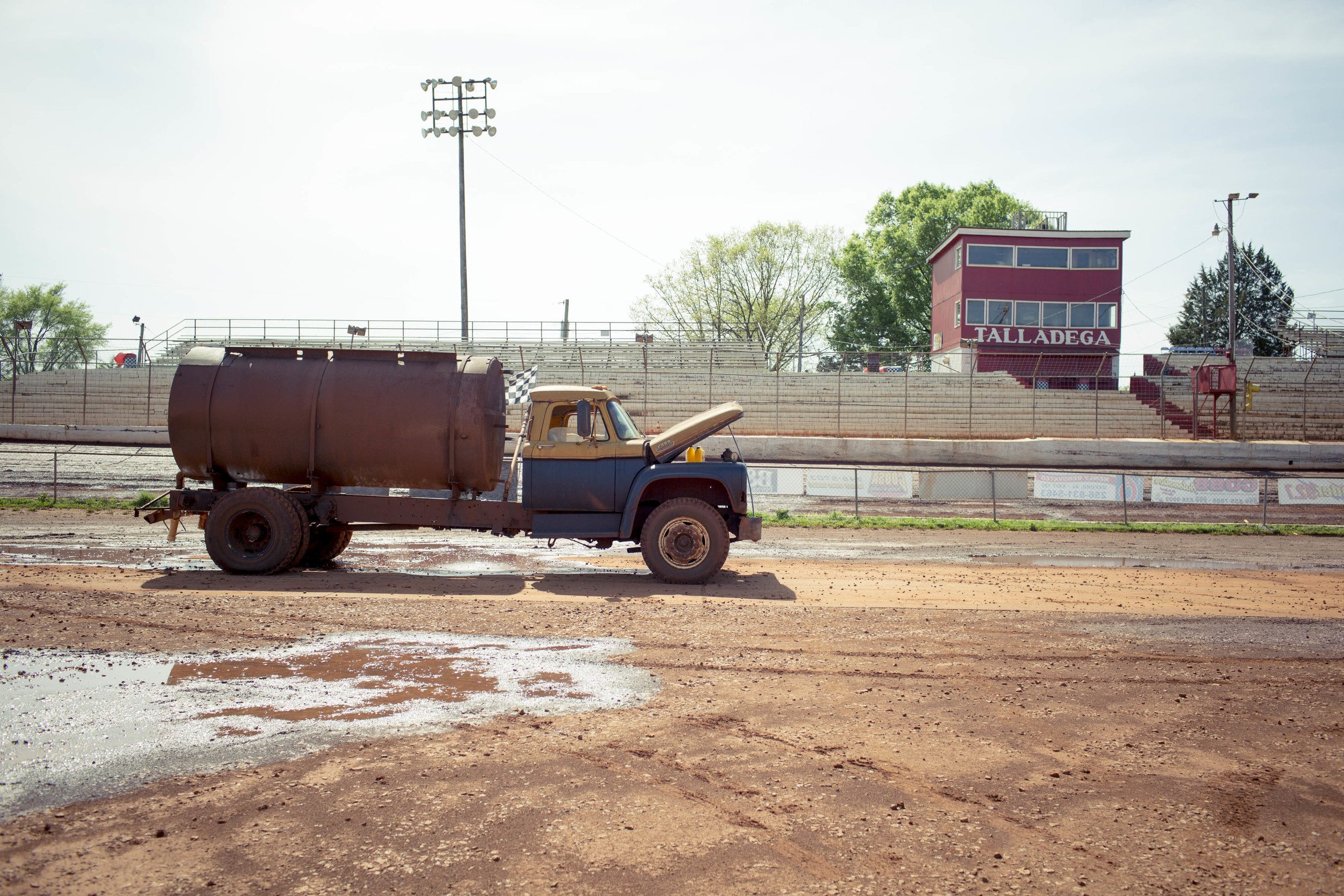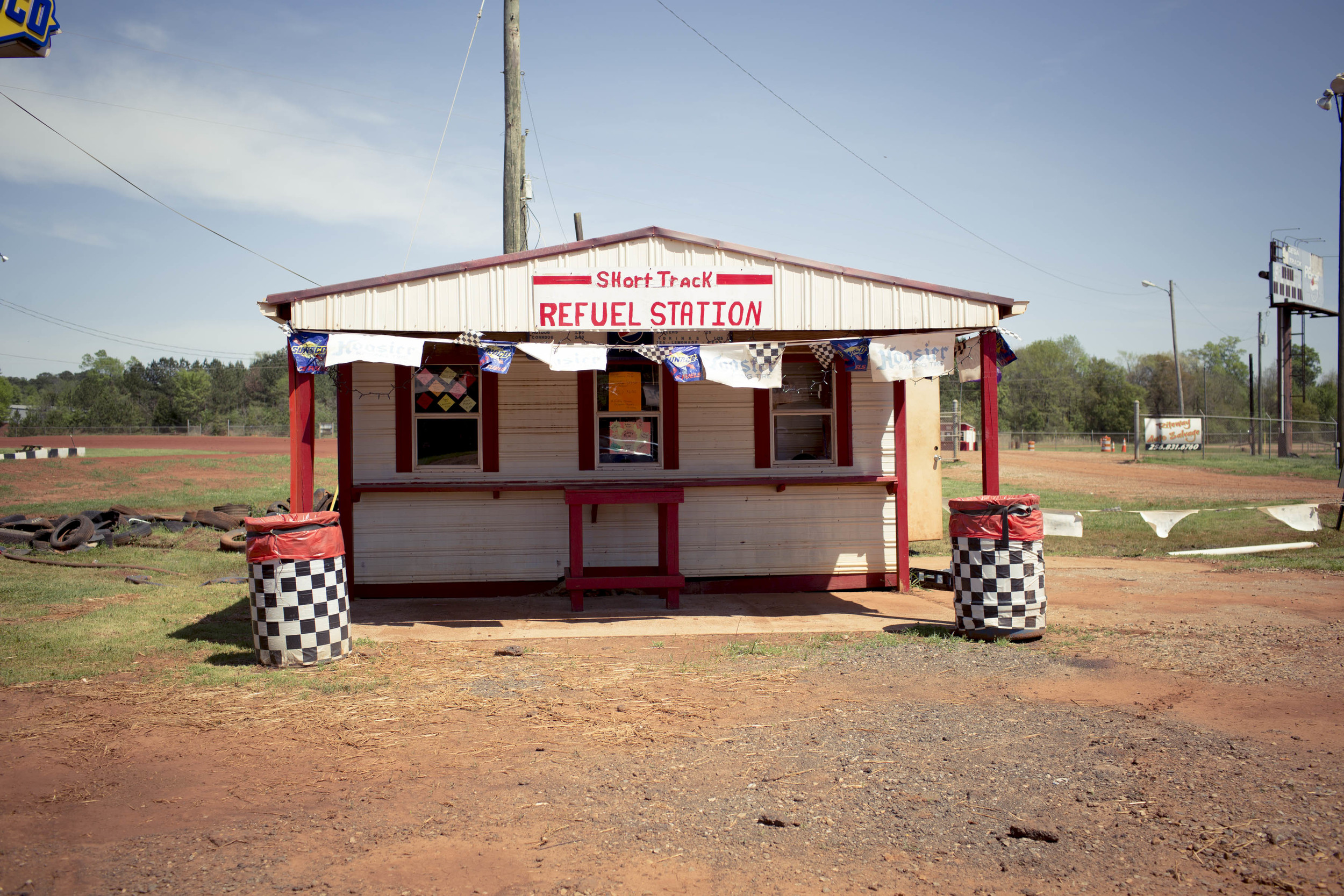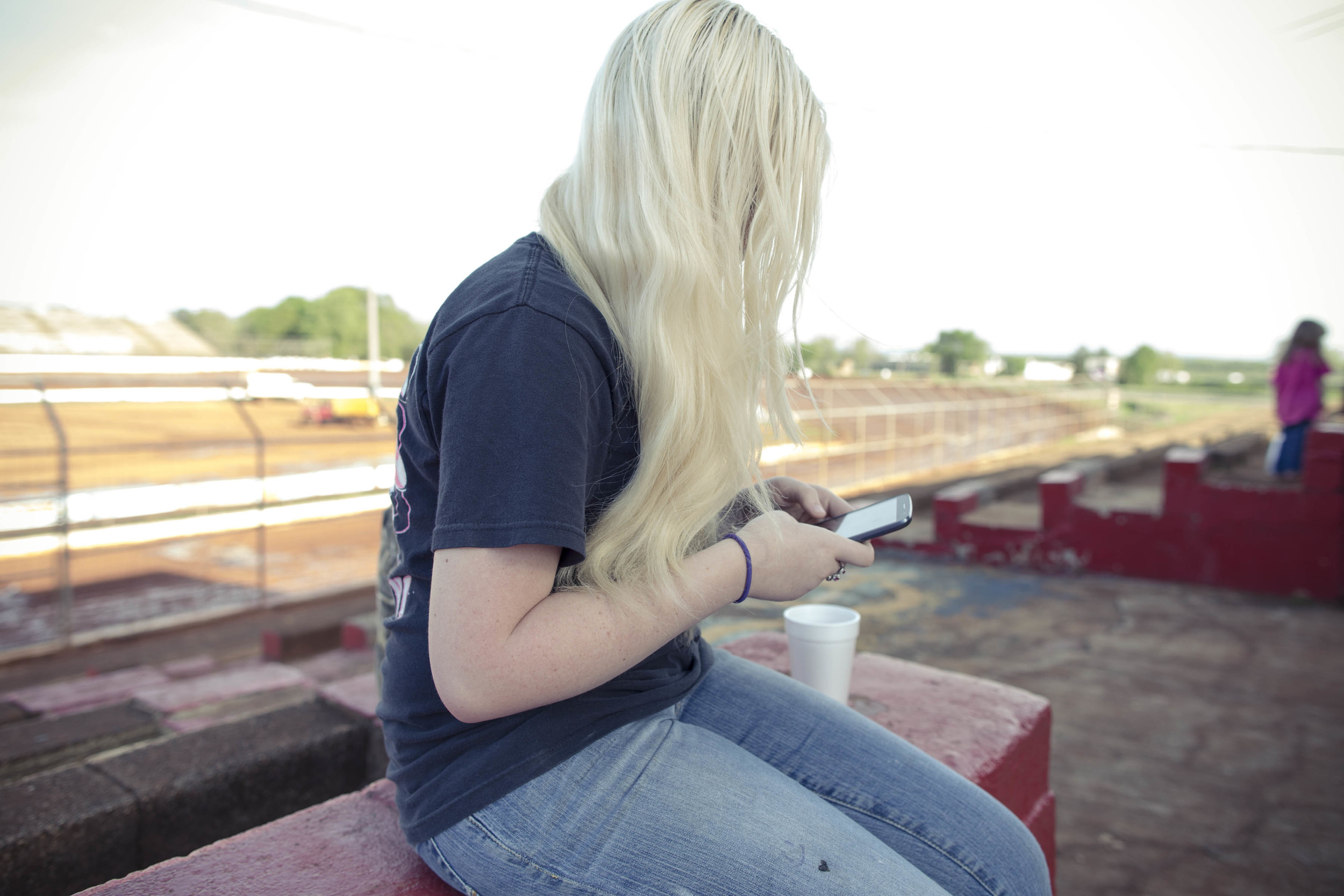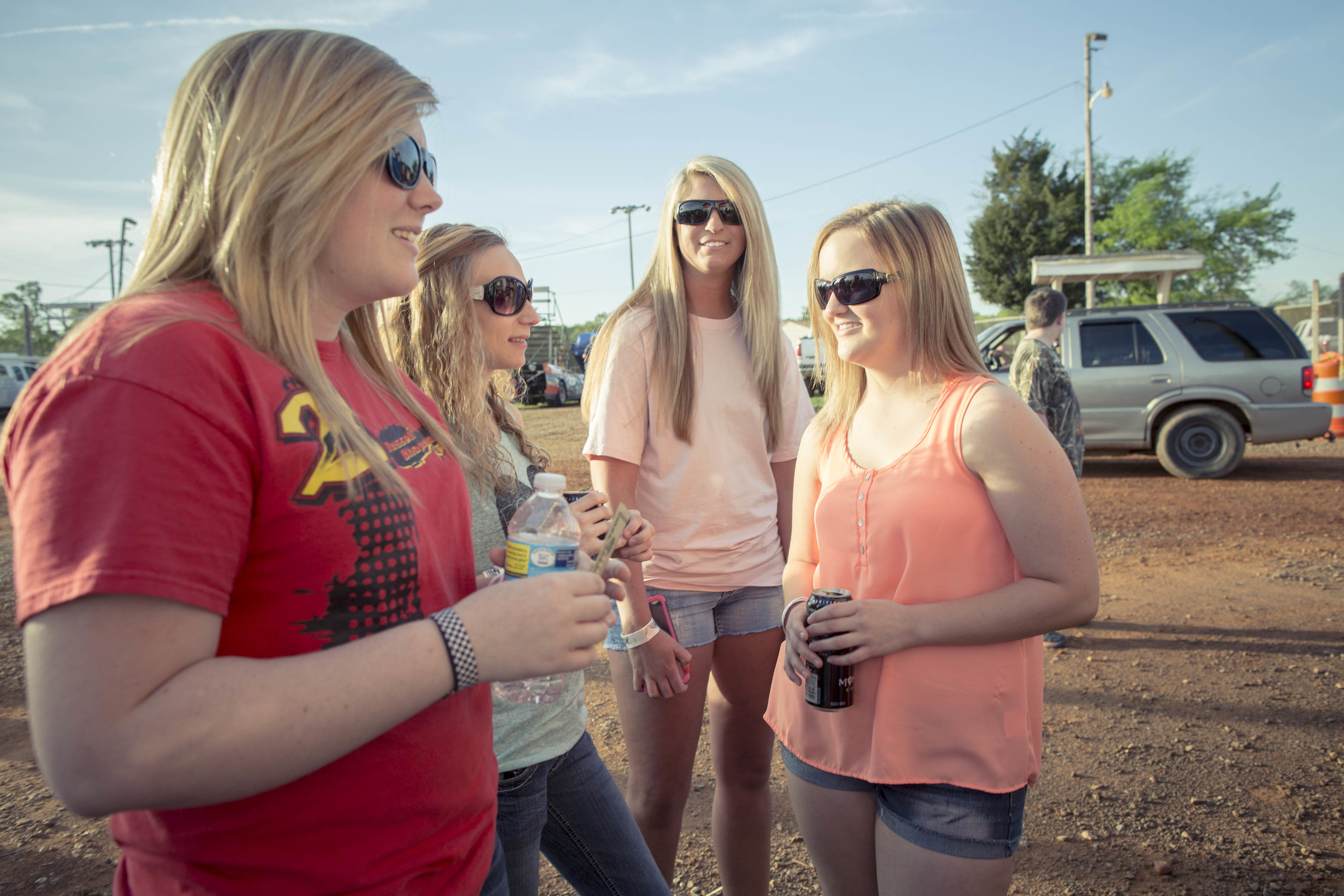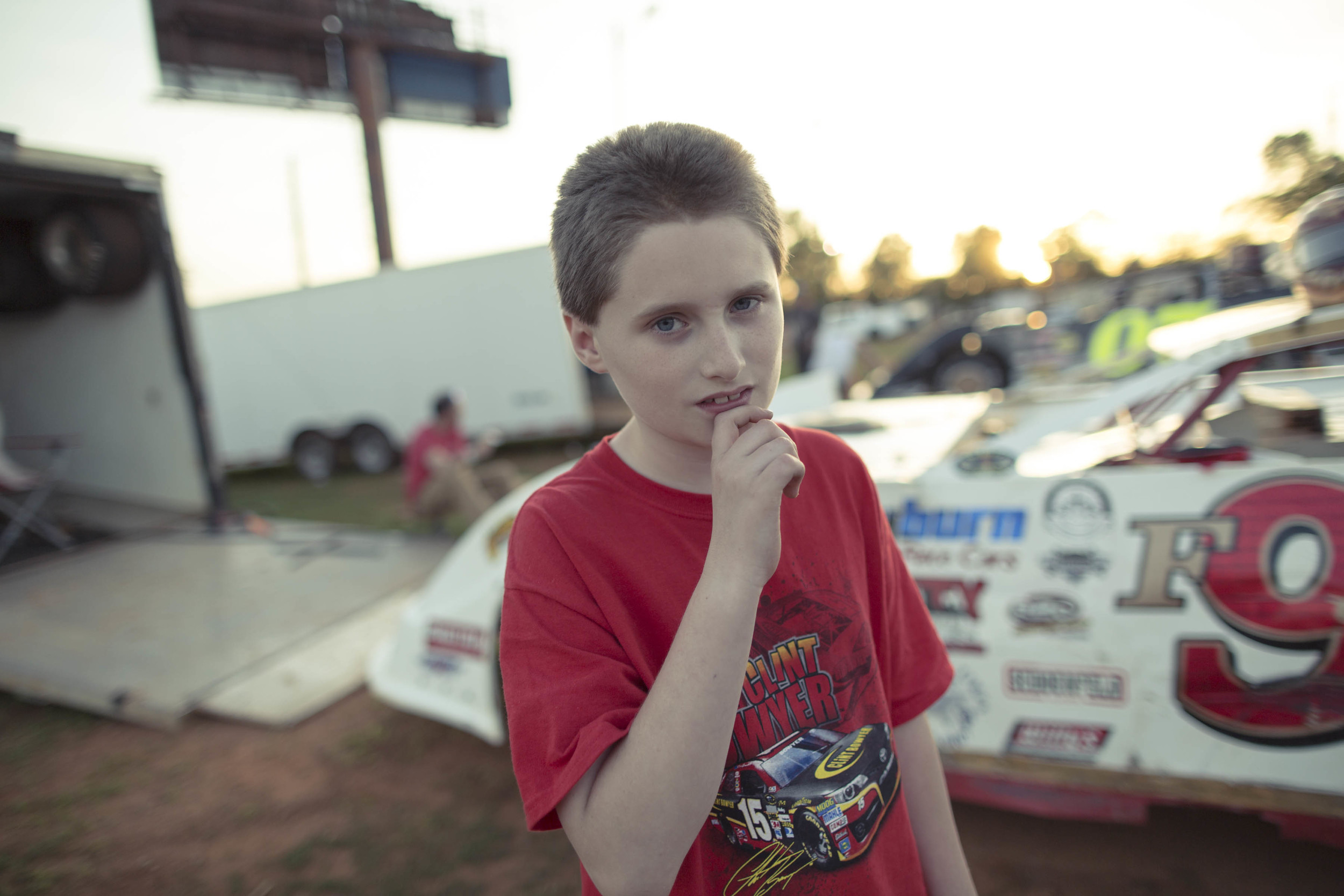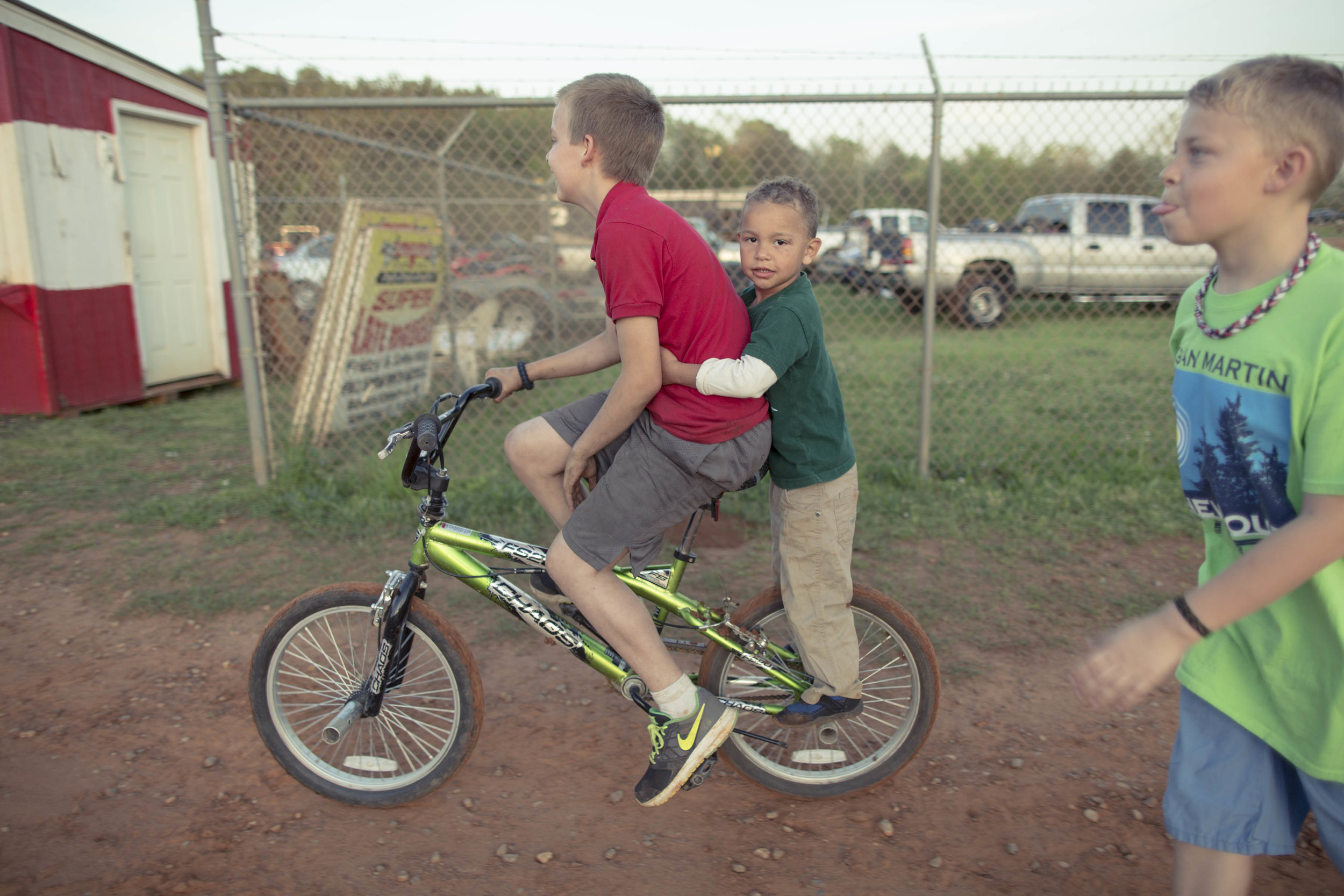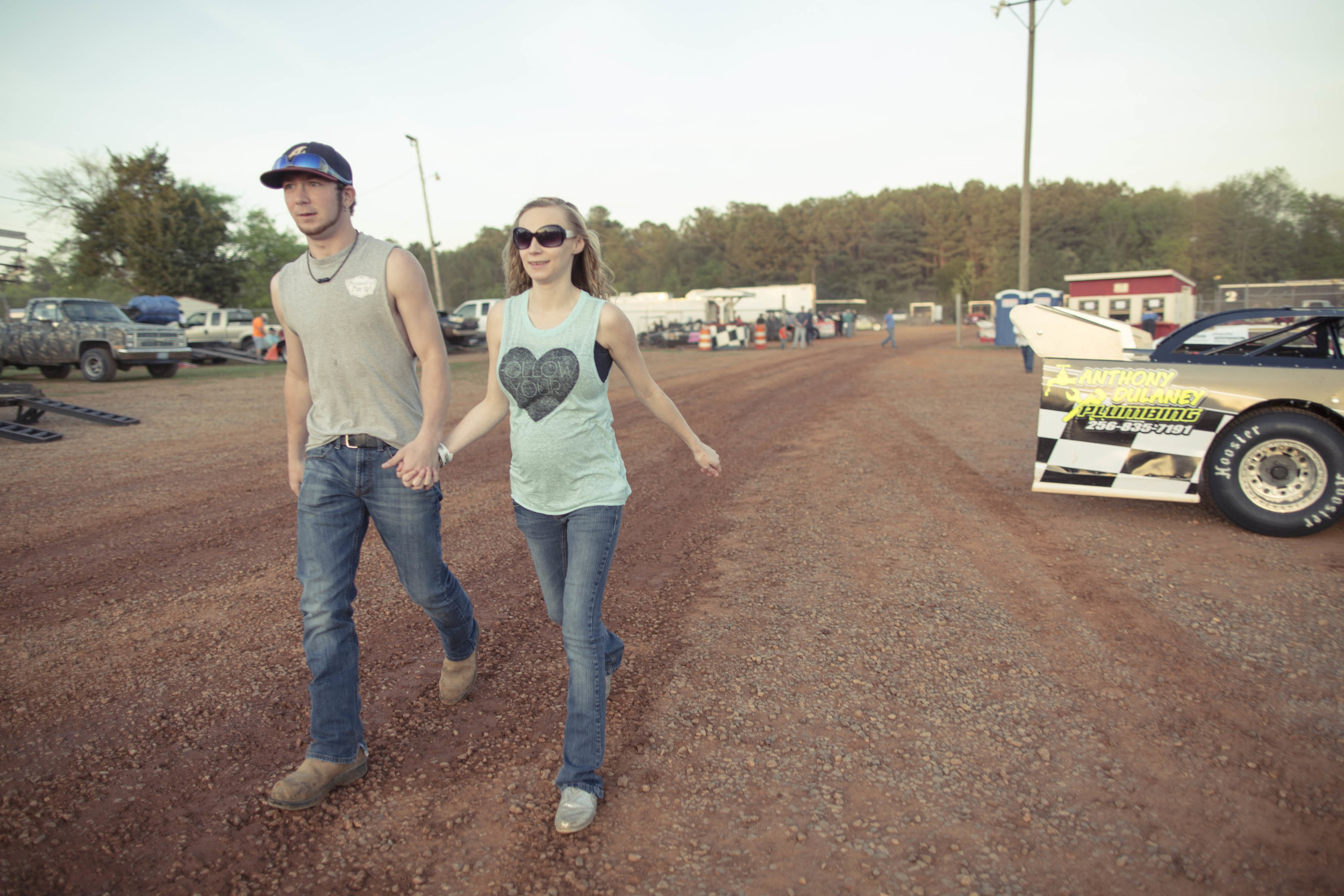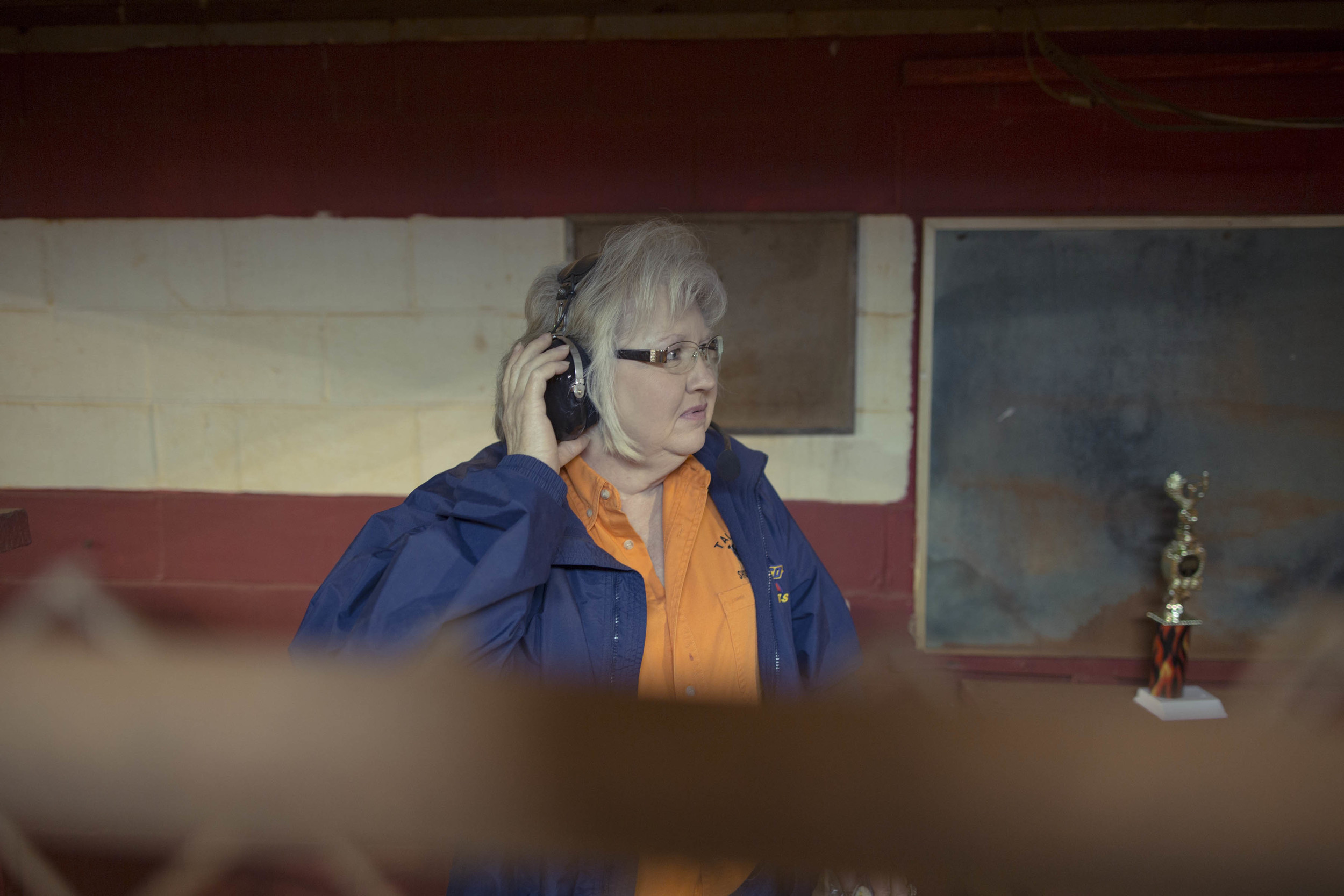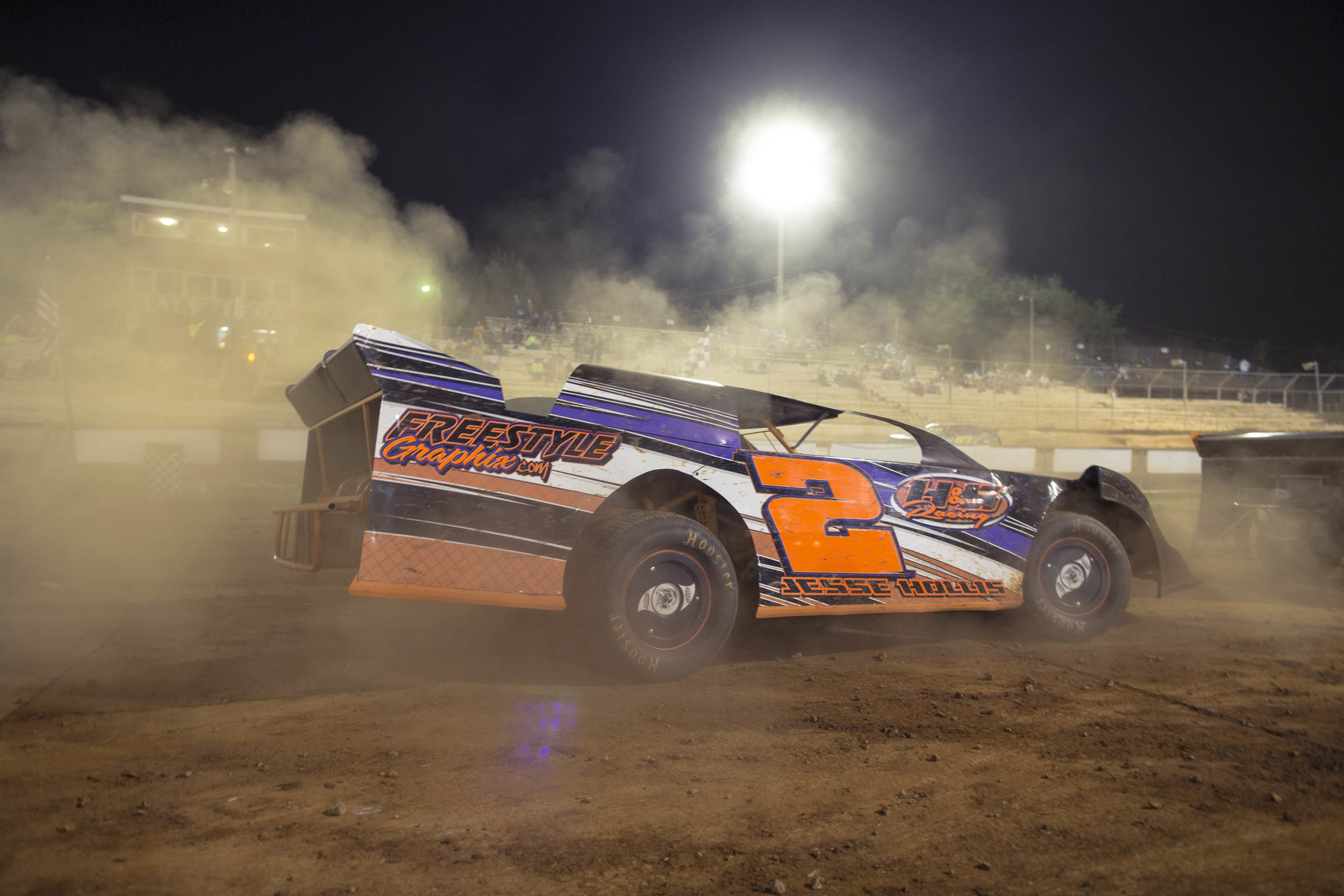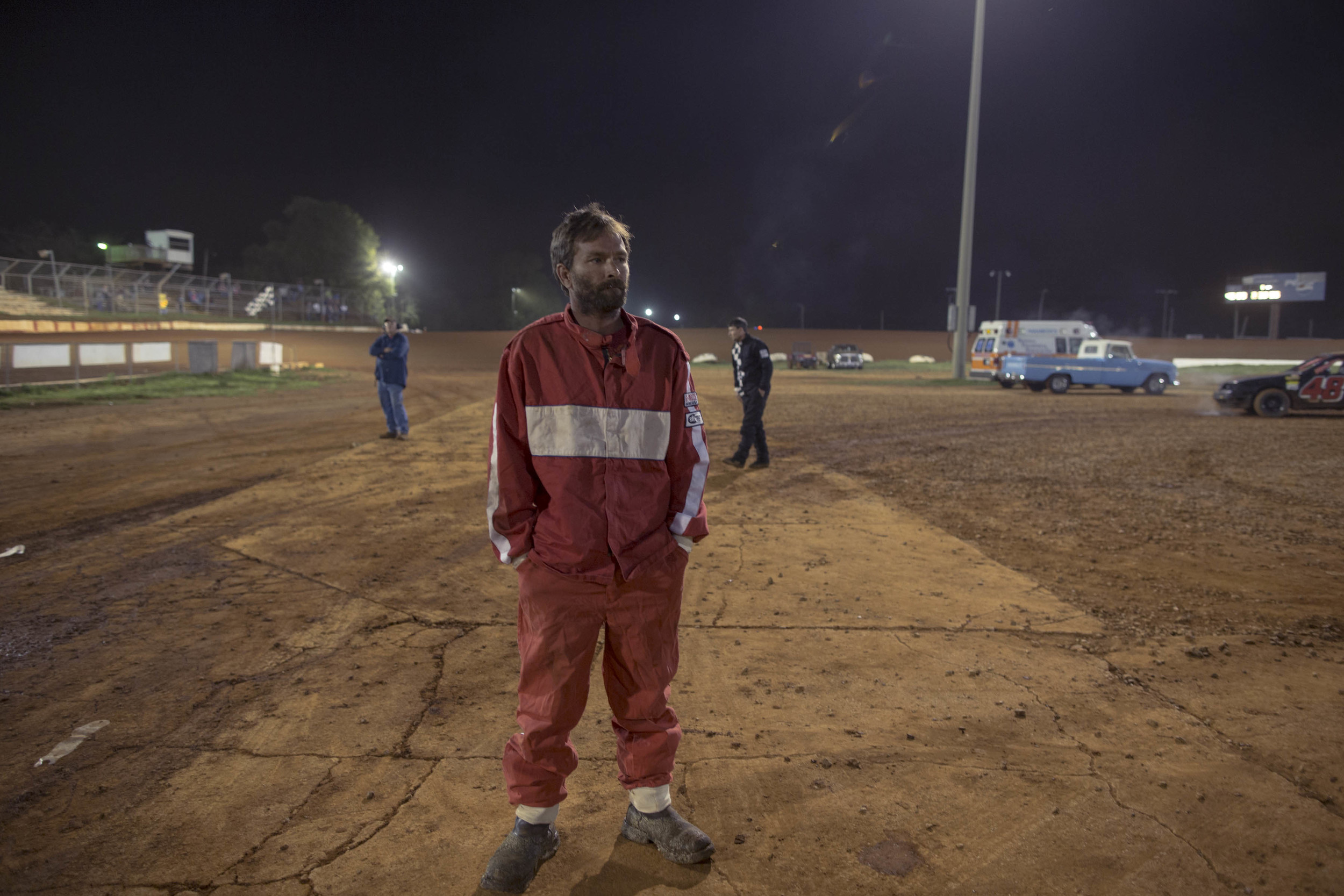The Last of the Alabama Gang
Red Farmer was the oldest of a group of Hueytown boys who dominated auto racing in the ’60s and ’70s. He's still racing the dirt tracks at age 82, and he can still outrun most things. Except maybe time.
In the noon sun of a bitterly cold January day at the Talladega Short Track, an 82-year-old race car driver worries about time.
His name is Red Farmer, and he holds a stopwatch in his chapped palm. His hands are black and oily with grease, and dirt is underneath his fingernails. He sits just beyond the track’s catch fence, close enough that the skidding cars on the other side leave a coat of red-clay dust on his glasses. He watches intently as his friend Luke Hoffner takes his race car — “Ol’ Yeller,” Red calls her — on the first round of her Friday “hot laps,” practice runs for Saturday’s qualifiers. Track officials are recording times for the drivers, but Red likes to track the seconds himself. He knows each one matters.
It smells like gasoline, and each time the cars come around the 1/3-mile dirt oval, it sounds like a plane taking off. Red leans forward in the golf cart — his “huntin’ buggy” — that he drives around the track’s complex, his mouth slightly agape beneath his white goatee. Years spent driving fast, trying to outrun the clock, have left their marks all over him. There are deep creases at the corners of his eyes, and grooves in the skin lining the back of his neck. Three of the fingers on his left hand are missing.
I’d heard stories about Red Farmer, the octogenarian race car driver, the oldest member of the legendary “Alabama Gang,” which dominated racing in the 1960s and ’70s. But I wanted to see for myself, so I came here to Talladega’s lesser known racetrack, one made of dirt, for its most popular event, the Ice Bowl, which has run every January for the past twenty-four years.
Red’s won at Daytona, and he’s won at the other, much bigger Talladega, and he’s already been inducted into the International Motor Sports Hall of Fame even though he hasn’t been retired for the requisite five years, because he might never retire. He’s been here for all 24 Ice Bowls, though five years ago, he couldn’t race because pneumonia hospitalized him for a few days at the end of December. He still came anyway, because what’s a little cold weather to a 77-year-old who just got over pneumonia?
Red’s parked on the backstretch, and each time Luke completes a lap, Red presses the stopwatch so hard his whole hand shakes, like someone is timing him time Luke. Luke runs three or four laps and then exits the track and heads back to Red’s hauler in the pits. Red backs his buggy up and as he’s turning around, I jump on the back. When he guns it, I almost fall off.
“I don’t wait for nobody,” Red shouts over the roar of the next round of cars coming onto the track. A few more seconds pass and he takes off down the hill, a longtime race car driver speeding off in his camo-upholstered huntin’ buggy.
“I ain’t got time,” he says.
Red Farmer, 82, is the only member of the legendary Alabama Gang still racing.
The Talladega Short Track is located on Speedway Boulevard, not far off I-20’s exit 173 for Eastaboga, Ala., and past two gas stations that sell fireworks, too. It’s marked with a big sign — “Talladega Short Track, Dirt Trackin’ Southern Style” — and a right turn will put you on the gravel path to the track, a long line of pickup trucks parked alongside. The immense grandstands of the Talladega Superspeedway are about a mile down the road. Here, at a short track made of dirt, NASCAR’s corporate presence hovers always but rarely touches. They are two racetracks on the same road and in different worlds, a body disconnected from its own beating heart.
The men and boys at Talladega Short Track are named John Parker and Jeff Jones and Kyle Smith and come from towns like Piney Woods, Ala., and Shelbyville, Tenn., and Jasper, Ga. They drive cars sponsored by Choice Concrete Walls or Oliver Trucking or Brewster Builders. They’re all over the dirty pits, red with clay and frozen to the bone on this early January weekend. They arc dipspit into Styrofoam cups or hold cigarettes between fingers so black with grease that you wonder if maybe their hands will never be clean again, if they’ve ever been clean before. They buy coffee and corndogs and Rolaids — only $1! — from ladies named Debbie and Loretta who work concessions and who will put chili and cheese on anything and probably won’t charge you for it either. They’ll give it to you and they’ll say, “Thank you, honey,” or, “Have a nice day, baby,” and you’ll think of your mom even if you haven’t seen her in a long time. They wear hoodies that say “There’s only 3 speeds: fast, really fast, and oh shit!” or “You dump it, we pump it.” There’s camo and Carhartt everywhere. They wear overalls and boots and work pants because when they race the cars they built, they are going to crash them, and when they do, they’ll rebuild them too, and then race them again. They are all the teenage driver from Clanton, Ala., who found a race official before the Ice Bowl started and asked, “What time is this going to be over? I borrowed the tires from Grammy’s car.”
And they are all Red Farmer too, a man who won Daytona in 1971 and Talladega in 1984 and 1988, but who likes racing over here, where dirt and grease get in your fingernails and skin, and where “you gotta drive with the seat of your pants, the feel of the car ... you got your ass. That’s it.” It’s more fun without the radios, or the spotters or the rearview mirrors they have down the way. Because sometimes you can’t look too far forward, and you don’t want to see what’s behind you either. You just want to keep running straight ahead. And sometimes all you have is your grandma’s tires, or your 82-year-old ass.
Today is Friday, and tomorrow will bring the qualifying races for the 2015 Ice Bowl, but Red’s not yet sure if he’s going to race or not.
“I don’t know what the hell I’m gonna do tomorrow,” he says, standing by his two race cars in the pits, in the shadow of a scoreboard that’s falling apart but is still in use, anyway. “I’m worried about today.”
It would be the start of yet another racing season, 67 years after he ran his first race at the Opa Locka Speedway in Florida. It wasn’t so much a “speedway” as an abandoned airport. The drivers would run down one runway, drive through the grass and dirt to another, and run back.
It was there in Florida where he started working with a young man named Bobby Allison, and not long after, Red, Bobby and Bobby’s brother Donnie came north to race in Alabama. They set out all over the Southeast — first from a one-bedroom apartment they all shared, and later from a garage in Hueytown — running cars wherever they could, working on each other’s race cars and towing them wherever they went, sharing rooms and meals, sometimes racing two races in one day, or three races in three cities in three days.
The Alabama Gang, they were called, because they were boys who lived and worked in Alabama, and because of the prize money they always took. They drove their way onto the NASCAR circuit and they won there, too. Red won three consecutive NASCAR Late Model Division championships from 1969 to 1971. Bobby’s son Davey started racing, and he became part of the Gang, and so did another Hueytown driver named Neil Bonnett. In February of 1988 Bobby Allison won the Daytona 500. Davey finished right behind him. Neil Bonnett finished fourth. Two and a half months later, Red won at Talladega Superspeedway.
The Alabama Gang was on top of the racing world with no way of knowing it was all about to start falling apart, before disintegrating completely.
Bobby Allison doesn’t remember edging his son at Daytona. In June 1988, he crashed in the first lap of the Miller High Life 500. He survived, but he would never race again and he would never get his full memory of 1988 back. Donnie quit racing not long after. He had crashed years earlier — in 1981 — and could never get back to being the driver he was before, the driver Bobby and Red had once raced with. Davey kept racing and in 1992, he won Daytona just like his dad before him. The following year, he was flying a helicopter to Talladega to watch Neil Bonnett’s son. It crashed and he died. Farmer was in the helicopter with him, but survived.
After the crash, Farmer and Bonnett were the only ones left of the original members. In 1994, Bonnett returned to the Daytona 500, which he would run without the Alabama Gang, and without the father and son he once finished just behind. He ran into a wall in practice. He died nearly six years to the day after the Alabama Gang took three of Daytona’s top four spots.
Red can’t ever forget the year his friend Bobby, now 77, won’t ever remember — 1988, the year Red won at Talladega and the year the Alabama Gang was still whole and alive, before they started dying off. They’d all walked away from crashes in their career but Red kept walking away when the others stopped. People started talking about a curse. Red had been Davey’s crew chief in the Busch series, and also like a dad and hero, too. Davey even named his dog Old Red Farmer. Red made it out of the helicopter wreckage Davey couldn’t. He was put back together, but loss leaves holes doctors can’t find, and though Red didn’t die, something did. He never raced at Talladega Superspeedway again.
Now, on a cold afternoon in January, he tries to decide whether to drive a race car or not, standing in the shadow of that racetrack and in the shadow of something else too. Like any shadow, it gets longer as the sun sets, until it settles over everything. It follows Red, reminding him that no matter how many times you go round and round the dirt oval, no matter how fast you run it, all drivers still end up at the same spot. He learned something watching racetracks and race cars harm or kill his friends: Race car drivers don’t die from driving but from hitting something so sudden and so final they could never hope to run through it. You don’t die from going too fast. You die when you stop.
Though he’s unsure about what he’ll do tomorrow, Red’s going to run in the second round of hot laps today.
Everyone wants to talk about how old he is, and how crazy it is that he’s still racing at his age. Maybe he likes that, because as long as people keep asking when he’s going to stop, he doesn’t have to answer other questions — from others or within himself — about the loss and suffering he’s endured and that’s robbed him of so much more than the 82 years have. And yet, for everything the racetrack has taken, it has given something too. The curse of so many drivers isn’t that they’re destined to die in their race cars, but that they won’t stop until they do. Racing is the salve for some soul-burning flame they can’t ever put out, that only driving fast can quench. Red’s been racing and working on cars since he was a young man — a boy even — since before there were meet-and-greets or lights or private jets or fancy haulers, and the racetrack’s been a home, a refuge through all of the pain. Racing is how he lives, and it’s how the rest of the Alabama Gang would’ve kept on living too.
Red has two race cars: the yellow and red GRT Model that Luke was racing earlier — it runs a Chevy motor — and a white Ford Rocket with a smaller Ford motor that he will run. Both cars run Hoosier Tires, and while many spoilers around the track have messages like “Jesus” or “To My Love” or “Thanks Dad” or “Roll Tide,” Red’s GRT says, simply, “Hoosier Daddy.” Really, the cars are nothing more than a few pieces of flimsy metal strapped over a roll cage, a steering wheel, a thin, uncomfortable seat and a motor that makes it all go very, very fast. There’s a Driver’s Prayer sticker pasted inside the car and a Racing With Jesus sticker just outside, because death hangs heavy at a racetrack, and, regardless of your religion, sometimes a roll cage isn’t enough.
Red was once 6’1” and 210 — he played football for the Army when he served in the early 1950s — but he’s smaller now. He’s trim and with a slight hunch, gravity slowly exerting its force over time, pulling him closer to the dirt he races on. He has the trace of a hobble, but when he swings himself through the driver’s side window of a race car, he’s remarkably lithe. He has only five whole fingers and two thumbs to hold the steering wheel, having chopped part of three fingers on his left hand off in his airboat propeller in the 1960s, before packing up the boat, driving it back to shore, hopping in his car, driving to the hospital and then racing later that weekend. Because Red Farmer is always moving, doing something: racing or working on a race car, hunting or fishing.
“You hunt? You fish? What do you do?” he asks me at one point.
Uhh, I write?
“That’s boring as hell,” he says.
Red fires up his engine and when he does, the whole car shudders violently, and the sparse grass growing up out of the dirt bends in the opposite direction, like it’s trying to run away. He faces forward in his Tasmanian Devil helmet and the car settles into a steady, pulsing rumble, both comforting and ominous, like there’s something deep inside that wants out. Red gets ready to head out onto a freezing racetrack in a dying sun and do the same thing he’s always done, still unsure if he’ll race tomorrow or not, because he’s worried about today.
No spotters. No rearview mirrors.
After he’s done, he’ll come back to the pits, and as the sky turns to black and his crew puts the cars up for the night, a man will approach Red with a flier for a race in April, asking if maybe he’d want to run in that race.
“April?” Red will ask. “Hell, I don’t even buy green bananas anymore.”
After Red leaves the racetrack for the night, his presence lingers in two pictures that hang in the press box at the Talladega Short Track. They’re on a dark wood plaque that says, “Race of Champions, May 4, 1990. A Night to Remember.” Here on a Friday night nearly 25 years ago, Red Farmer outran The Intimidator himself, Dale Earnhardt. Earnhardt won an IROC race down the road at Talladega Superspeedway the very next night, before winning the Winston 500 on Sunday, too.
The short track’s press box sits inside a red cinderblock square at the back of the bleachers. The carpet is red and stained, and the room is wood-paneled. There’s something musty and vaguely crotchety about it. If it were a person, it’d probably hate the sound of those damned race cars on the track below. An empty fridge and a square, clunky television with hand dials on the front sit against the right wall. An open storage room has fiberglass insulation poking out of the walls. There are blue-cushioned chairs in a row at the front of the room, facing out the square windows and onto the track below. In the night outside, the Ice Bowl’s smallest division is running its heat race, and the car next to Red’s in the pits is out there racing, the black one with both a green number and a “For Sale” sign taped to it. The barriers on the inside of the track — between the cars and the infield — are white, and a small fence above them is covered with sponsoring businesses: Riteway Bail Bonding (“Get Out of Jail Almost Free”), O’Reilly Auto Parts and Oxford Love Stuff, an adult store that once supplied a box of promotional gift bags that included some unlabeled pills in a plastic bag. The glass windows and cinderblock structure dull the buzz of the cars’ motors, but the sound hovers constantly.
This buzz, which gave the track its nickname, the Hornet’s Nest, has been the background noise to Rita Donahoo’s life. She’s 53 and has been coming to this track since 1983 and says she’s done “every job here,” or, as PA announcer Eddie Davis puts it: “She pretty much runs this shit.” She has dirty blond shoulder-length hair that’s big and curly. She wears a blue and yellow Sunoco-branded jacket over a sweatshirt and blue jeans. Rita grew up among brothers and her grandfather used to take them to the track, but told her, “This is not for girls.” She came anyway, and in 1983 a driver named Mike asked her to score for him, since the track did — and still does — use hand scorers. That was their first date. Now they’re married and their son Mikey is a flagman here, and she likes that family feel. Kids 9 or younger still get in free, and entire families can spend a night at the track for just $20. The kids sit right along the catch fence and pick a favorite driver for the night. They look through the metal wire and they see young drivers from nearby towns or states, and that’s a distance they can measure. At least three people will tell me that dirt racing is “grassroots racing,” where anyone with a car can run — even if that car’s for sale.
Rita points out the two cars running in the current heat, one of which looks like it just left a demolition derby, and one that runs up front and looks faster than it is because it’s shiny and bright and looks like a real race car.
“It can look like that without the fancy lettering job or it can look like this car here in second place with that really neat job,” she says, before bringing attention back to the beat-up looking car. “This guy, he may not run out front, but he can still get out there and have fun with them.”
That’s not the case with NASCAR, where big money rules. Bobby, Donnie, and Red ran at a time where the gulf between a clay short track and an asphalt speedway wasn’t so wide, when NASCAR was still a sport grounded in the Southern dirt it came from. Rita remembers the days when NASCAR drivers would make the short drive down the road from the Superspeedway to come here. Her son would throw a football with their sons.
“They would run with our late model drivers,” she says. “But then it became to where these guys were as big and, you know, insurance property. You didn’t want them to get hurt.”
Soon, the heats will be over, and the 200 or so people scattered throughout the bleachers will gather up their blankets and their space heaters and head back to their cars. They’ll be covered in red clay. It’ll be on their boots and jeans and in their eyes and in their mouths. They’ll get it in their cars when they drive out past the sign that says “drive safely” on the way out but not on the way in; and they’ll track it in their houses when they get home, because clay sticks to you in a way that asphalt can’t.
“They’re not of the people anymore,” Rita continues.
A phone rings somewhere in the press box.
“But when they were to where you could meet these people and see ’em, they were real humans” — the phone rings loudly again and Rita seems to notice this time — “and they were heroes.”
She stands up and walks to the other side of the room.
“Then they became celebrities,” she says over her shoulder before picking up the phone.
Rita Donahoo, who's been working the Talladega Short Track since 1983 when she met the driver who would go on to become her husband.
Red Farmer never left. He still races here, and though he may be older, he’s still a damn good driver. But he can’t race forever, and soon the only Red Farmer at the Talladega Short Track will be the one in the pictures hanging on the back wall. There’s one of him shaking Earnhardt’s hand and one of him solo, posing with the checkered flag and his winning trophy. Earnhardt’s dead, and only Red remains, except, in both photos, he’s completely washed out, the details of the picture fading with a quarter-century of time. There is his car, and the track, and the people in the stands, but inside the outline of Red’s body, the only distinguishing marks are the barely visible lines of his fire suit. He’s a glowing, white ghost, and there’s a blank space where his face should be.
Saturday morning is beautiful and blue and windy. American flags flap in a wind that smells like America too, reeking of cigarettes and gasoline. Red’s worried about his race car, because he’s always worried about his race car, because that’s easier than worrying about other things. Because when a race car wrecks, you can build it back into what it once was, and make it faster, more efficient. Because there’s always another race for a car.
His tires keep wearing out. The turns are tighter on dirt because the track is smaller (the straightaways are only 400 feet vs. about 4,000 at the Superspeedway). Cars whip around them, drifting or sliding in a way that’s more violent than it is on asphalt. The cars screech and the tires get hot, which helps them connect with the track, until, eventually, they get torn up. The key is finding a tire that’ll get hot without wearing out, and then hoping the caution flag doesn't come out, because when a car slows down, its tires cool off, messing up its rhythm. A fast-going race car never wants to stop.
When Red decides on the tires to use, the crew cut grids in them so they can better grip the track. Then they put them on and get the cars ready to race: checking the oil, monitoring tire pressure, refueling. The cars are clean because Red has them wiped down at the end of the day. The crew clean off the red clay and the oily grease, and it gets on them, their hands and clothes getting dirtier and blacker.
Red always works with them, a driver and his crew. But today, he’s on the same side, preparing the car for someone else, because after his time trials and his preparation, he has decided he can’t race, and the reason is a reminder that mortality is unflinching and unsentimental: His stomach is acting up, and he worries the bumps of a dirt track might make him shit his pants, making dirty the car he likes to keep unsoiled.
“I ain’t cleanin’ the seat,” his crew chief says.
Red’s grandson, Lee Burdett, is going to run in his place, as he has before. All Red can do is watch and hope that the tires run well and run fast and hook up to the track, and that when they do, they don’t give up before the race is over.
Maybe one day Lee will replace Red in this car permanently, or some other driver will, giving new life to an old car. Today, it was his stomach. Five years ago it was pneumonia. Humans aren’t race cars. They get old. They can’t be wiped clean or put back together or rebuilt. They can’t be made better or faster, and with each race that passes Red by, the old man he’s become grows a little farther from the young man he used to be.
Discover the Talladega Short Track through the lens of photographer Tamara Reynolds. Click through and see the faces of the people who call it — and who make it — home.
Red sits in the grandstand named after him (just as the bigger Talladega’s backstretch is now named “The Alabama Gang Superstretch”), wearing a tan, hooded Carhartt jacket that says “Red Farmer Racing” across the back and waiting for his cars to come onto the track and run as fast as they can, trying to outrun the stopwatch that tracks every second gone.
When Lee finally crests the hill, trailing red clay in his wake, the PA system announces his arrival, booming excitedly.
“...and celebrating his one millionth year of racing, the 97 car of Red Farmer!”
Red Farmer isn’t in the car. He’s sitting in the Red Farmer Grandstand, across the track from the press box where a fading picture of him hangs in the shadows of a dark room, watching younger men do what he’s done for so long. He’ll sit and watch intently as the cars go around and around and around, until the race is over and they stop and they turn their engines off, and all that’s left is a cloud of dust and a deafening silence in the wake of so much noise.
































